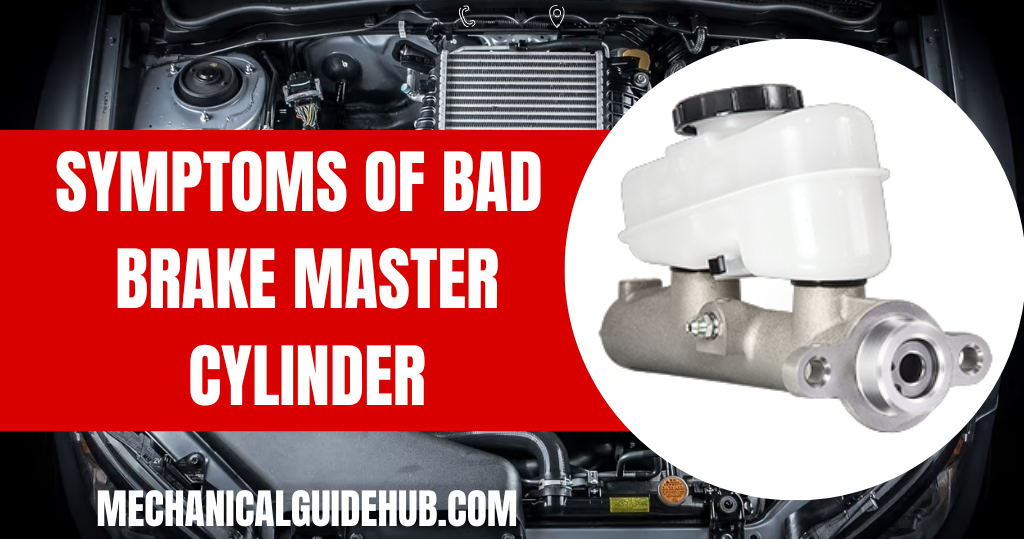Symptoms of Bad Brake Master Cylinder
Published: 16 Oct 2025

Your car’s braking system is one of its most crucial safety features, and at the heart of it lies the brake master cylinder. This component converts the pressure applied to the brake pedal into hydraulic force, which sends brake fluid through the system to slow down or stop the vehicle. But when it begins to fail, your brakes can lose their efficiency, putting you and others on the road at risk.
Understanding the symptoms of a bad brake master cylinder helps you detect problems early before they lead to costly repairs or dangerous situations.
Symptoms of Bad Brake Master Cylinder
1. Spongy or Soft Brake Pedal
A soft or spongy brake pedal is often the first sign of a bad master cylinder. When the internal seals wear out, the hydraulic pressure weakens, causing the pedal to sink lower than usual or feel less firm when pressed. This loss of pressure can make your car take longer to stop.
2. Brake Warning Light
If the brake warning light appears on your dashboard, it could signal a pressure issue or a fluid leak in the master cylinder. The light doesn’t always mean worn brake pads — it can also indicate an internal leak or malfunction within the master cylinder itself.
3. Brake Fluid Leaks
Brake fluid leaks are a clear indicator of a problem. If you notice fluid around the master cylinder, under the pedal, or near the firewall, the cylinder’s seals are likely damaged. Even a small leak can compromise hydraulic pressure, making braking unsafe.
4. Contaminated Brake Fluid
Over time, rubber seals and internal parts can degrade, contaminating the brake fluid. This makes the fluid look dark brown or dirty instead of clear. Contaminated fluid reduces braking performance and can corrode key components, leading to premature system failure.
5. Uneven or Weak Braking
If your vehicle doesn’t stop evenly or pulls to one side while braking, the master cylinder may not be distributing pressure correctly. Since most braking systems are split into two circuits, a fault in one half can cause uneven performance or complete failure on one side.
Conclusion
The brake master cylinder plays a vital role in maintaining your car’s braking efficiency and safety. If you experience a soft pedal, fluid leaks, warning lights, or reduced braking power, it’s time to have your system inspected. Replacing a faulty master cylinder not only restores proper braking but also ensures your safety on every drive. Always get it checked by a certified mechanic to prevent potential accidents.
FAQs
A bad master cylinder often causes a spongy brake pedal, fluid leaks, warning lights, or uneven braking. If your brakes feel weak or inconsistent, it’s a strong sign that the master cylinder may be failing.
If the brake pedal feels hard, you hear a hissing sound, or your engine stalls when braking, the brake booster may be the issue. It helps reduce the effort needed to press the brake pedal.
Low brake fluid can cause a soft pedal, poor braking response, or activate the brake warning light. It’s often a sign of leaks or worn-out seals inside the master cylinder.
You should replace the brake master cylinder if you notice brake fluid leaks, a sinking pedal, or contaminated fluid. A professional mechanic can confirm the issue by testing the hydraulic pressure and inspecting the internal seals.

- Be Respectful
- Stay Relevant
- Stay Positive
- True Feedback
- Encourage Discussion
- Avoid Spamming
- No Fake News
- Don't Copy-Paste
- No Personal Attacks

- Be Respectful
- Stay Relevant
- Stay Positive
- True Feedback
- Encourage Discussion
- Avoid Spamming
- No Fake News
- Don't Copy-Paste
- No Personal Attacks


